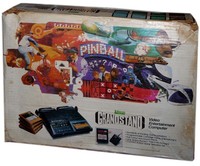Adman Grandstand (Fairchild Channel-F) Video Entertainment Computer
| Home > Browse Our Collection > Games Consoles > Grandstand > Adman Grandstand (Fai ... ntertainment Computer |
|
The Fairchild Channel F is a game console released by Fairchild Semiconductor in August 1976 at the retail price of $169.95. It has the distinction of being the first programmable ROM cartridge-based video game console. It was launched as the Video Entertainment System, or VES, but when Atari released their VCS the next year, Fairchild renamed its machine. The Channel F was designed by Jerry Lawson using the Fairchild F8 CPU, the first public outing of this processor. Notably, Robert Noyce worked on the F8 design team before he left Fairchild to start his own company, Intel. The F8 is very complex compared to the typical integrated circuits of the day, and had more inputs and outputs than other contemporary chips. Because chip packaging was not available with enough pins, the F8 is instead fabricated as a pair of chips that had to be used together to form a complete CPU. The graphics are quite basic by modern standards. The F8 chip was only able to produce single-coloured sprites, and only had eight colours to choose from at a resolution of 128 × 64 with 102 × 58 pixels with help from only 64 bytes of system RAM, half the amount of the Atari 2600. The F8 processor at the heart of the console was able to produce enough AI to allow for player vs. computer matches, a first in console history. All previous machines required a human opponent. In the original unit, sound is played through an internal speaker, rather than the TV set. However, the System II passes sound to the television through the RF switch. The controllers are a joystick without a base; the main body is a large hand grip with a triangular "cap" on top, the top being the portion that actually moved for eight-way directional control. It can be used as both a joystick and paddle (twist), and not only pushed down to operate as a fire button but also pulled up. Effectually, it had four action buttons, two more than the Nintendo Entertainment System nearly a decade later. The model 1 unit contains a small compartment for storing the controllers when moving it. The System II featured detachable controllers. Zircon later offered a special control which featured an action button on the front of the joystick. A number of licensed versions were released in Europe, including the Luxor Video Entertainment System in Sweden, Adman Grandstand in the UK, and the Saba Videoplay, Nordmende Teleplay and ITT Tele-Match Processor, from Germany and also Dumont/Barco Videoplay - Italy and Belgium. This example in our collection is the UK Adman Grandstand version. Manufacturer: Fairchild This exhibit has a reference ID of CH5768. Please quote this reference ID in any communication with the Centre for Computing History. |
Click on the Image(s) For Detail
|












